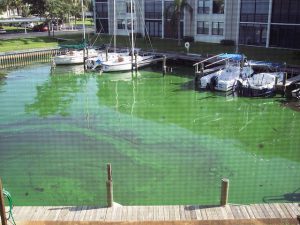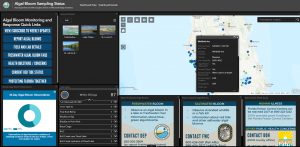
Originally published June 28, 2019. Updated July 14, 2020.
Note: For a quick list of resources related to blue-green algae blooms, just scroll to the end!
Summer is here. Sunshine, high temperatures and drenching rains are what make Florida summers so spectacular. These environmental conditions can also favor spectacular algae blooms.
Heavy rainfall results in high levels of water that run off from the land and into our waterways. This runoff brings with it nutrients, and high levels of nutrients, coupled with warm temperatures and ample sunshine, provide the perfect conditions for algae to bloom. Florida Sea Grant recently created an overview related to harmful algal blooms in Florida that provides an excellent summary of these phenomena: Harmful Algae Blooms Affecting Florida’s Coast.
Algae blooms may occur in fresh water (rivers, streams, lakes and ponds) or salty water (estuaries, bays, open ocean). Worldwide, there are thousands of species of algae that can create blooms, and hundreds of species that may create conditions that are harmful to humans. Harmful algal blooms may impact humans directly via health risks, or indirectly by negatively impacting local ecosystems and economies. In coastal southwest Florida, we are all too familiar with red tide, a marine algae that sporadically results in severe blooms that can be devastating to coastal communities.
In Florida’s freshwater systems, cyanobacteria (aka blue-green algae) are typically the culprit (even though cyanobacteria are actually photosynthetic bacteria, not algae!). Multiple cyanobacteria species are capable of producing harmful toxins (cyanotoxins). Some bloom forming species include Microcystis, Cylindrospermopsis, Anabaena, Aphanizomenon, Lyngbya, and Planktothrix . These blooms can result in abnormally colored water (often bright green) or floating “muck mats,” and may create health risks for humans, pets and livestock.

How do we know what is happening in our area? Florida Department of Environmental Protection is the state agency charged with monitoring algae and cyanobacteria blooms in fresh water. FDEP staff sample locations throughout Florida on a regular basis and are available to respond to blooms when they are reported: FDEP Freshwater Algal Bloom Sampling Status. You can also subscribe to weekly updates from FDEP. If you suspect you are witnessing a bloom, please report your observations to FDEP (hotline 855-305-3903).
What are the health risks? To date, there have been very few human illnesses reported in the U.S. Recreational exposure (swimming, skiing, boating) may cause “hay-fever” like symptoms, and ingesting contaminated water can result in gastrointestinal distress (tummy trouble). The Florida Department of Health has a webpage dedicated to Aquatic Toxins from Harmful Algal Blooms, and they recommend taking these steps to reduce your risk of exposure:
- Do not drink, cook or shower with untreated water from lakes, ponds or streams.
- Do not allow pets or livestock to swim in or drink scummy water.
- If you or your animals accidentally get into a blue-green algae bloom, wash with fresh water and soap after skin contact, and avoid swallowing or inhaling water. Wash animals’ fur thoroughly before they start to groom themselves.
- Avoid exposure to irrigation water drawn from untreated sources.
- Notify your local water quality officials if you notice unusual changes in the taste or smell of your tap water.
- Avoid eating fish taken from an area where there is an active fish kill (lots of floating dead or struggling fish at the surface.)
If you suspect you are in an area that is experiencing a harmful algal bloom, report the incident to FDEP or FWC and minimize your exposure by reducing or avoiding direct contact with the water (i.e., refraining from swimming/wade-fishing/diving).
Resources:
- Florida Department of Environmental Protection (FDEP) for data as related to location, timing and results of freshwater samples.
- Florida’s Department of Health provides beach and fish consumption advisories for concerned citizens.
- FWC Fish and WIldlife Research Institute to report a fish kill or for general information as related to cyanobacteria and other harmful algae.
- Contact your local County Health Department for health related information that is specific to your area.
- More about cyanobacteria and cyanotoxins from the Environmental Protection Agency.
- Visit Florida Sea Grant’s Bite-Sized Science Seminar Series for multiple presentations regarding Harmful Algal Blooms in Florida.
- Florida Atlantic University and the U.S. Geological Survey educational series: Understanding Algal Blooms in Florida
- For a wealth of data as related to water resources in Florida, check out wateratlas.org.
For a similar blog about Florida’s Red Tide, check out Tips for Tracking Red Tide.
 0
0
